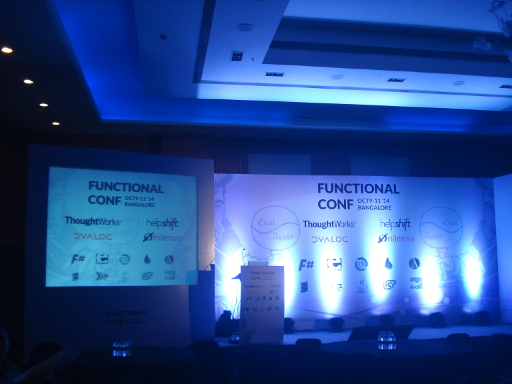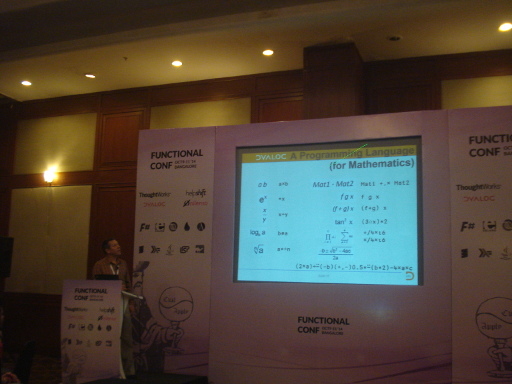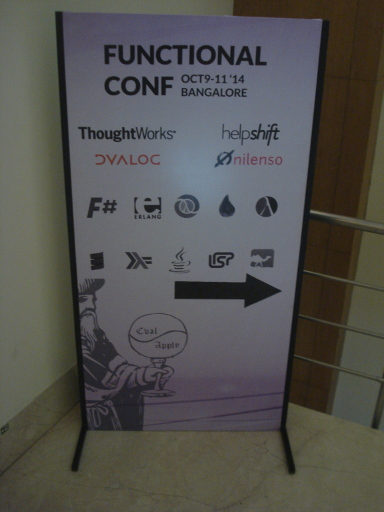I attended Functional Conf 2014 between October 9-11, 2014 at Hotel Chancery Pavilion, Bengaluru.
Day I

The first day began with the keynote by Dr. Venkat Subramaniam on the “The Joy of Functional Programming”. The talk was centered around what is ‘mainstream’, and why something that is mainstream is not necessarily the ideal approach. He gave examples on writing functional programs in Java, and how these code expressions are easy to read and test.
I then attended the talk on “Functional Reactive UIs with Elm” by Shashi Gowda. He gave an introduction to the Elm functional programming language with UI reactive examples. The syntax of Elm is similar to that of Haskell. The idea is to write less code for creating interactive applications, and Elm generates HTML, CSS and Javascript. There are also d3.js bindings for Elm.
The talk on “Applying functional programming principles to large scale data processing” by Kishore Nallan from Indix introduced the “Lambda Architecture”. They scrap product details from web pages worldwide, and receive 4 TB of data every day. The architecture uses an append-only database, and has multiple readers and views for the data. You can check their engineering.indix.com/blog for more information on their attempts to process large data. Scalding, Cascading, Apache Spark, and Storm are tools that they are experimenting with.
Thomas Gazagnaire talk on “Compile your own cloud with Mirage OS v2.0” was very interesting on how they stripped down the entire OS and applications, and re-wrote them in OCaml for use in production environments. The Mirage OS is a unikernel and targets the Xen hypervisor. It is type safe, and faster to deploy and use. It uses light-weight threads. OPAM is the OCaml Package Manager. IRMIN is an example of a distributed database implemented in OCaml. The TLS protocol was implemented in pure OCaml and deployed as a service. The demo server is available at tls.openmirage.org.
“Property based testing for functional domain models” by Debasish Ghosh introduced the concept of generative data for tests in Scala. The idea is from the QuickCheck library and property-based testing in Haskell. This allows you to focus on executable domain rules. We can get some properties for free in statically typed languages. He mentioned shapeless, a type class and dependent type generic programming library for Scala, and also Algebird, which provides Abstract Algebra for Scala.
Vagmi Mudumbai wrote a simple TODO MVC web application using ClojureScript and Om in his “ClojureScript and Om - Pragmatic functional programming in the Javascript Land” talk. Clojure and ClojureScript can help you write concise code for the problem you want to solve. The immutability of Clojure and the DOM manipulation mutability of React.js complement each other well in implementing performance-savvy web sites.
“Learning (from) Haskell - An experience report” by Aditya Godbole was an attempt to teach functional problem solving using Gofer in an organization, and the lessons learnt.
At the end of the day, a Fish Bowl was organized where people discussed the choice of functional programming language for development, and the also shared their experiences on how they solved problems in the industry using functional programming.
After dinner, there was a BoF session on Clojure, but, it ended with mostly discussions on different programming paradigms, and functional programming languages.
Day II
The first keynote on the second day was by Bruce Tate on “Fear: The Role of Fear in Language Adoption”. He classified the challenges in moving to functional programming into two categories - paralyzing fears and motivational fears. The paralyzing fears are on adoption, cost and getting developers. These can be overcome by building communities, having object-oriented languages implement functional programming features, better deployment options, and with cleaner interfaces. The motivating fears can be overcome by the need for handling code complexity, software to run for multi-core and large distributed systems, and for solving complex problems. He also mentioned that he sees three large programming language communities today - a hybrid, only functional programming, and the JavaScript land.

Morten Kromberg introduced APL (A Programming Language) and Dyalog in his “Pragmatic Functional Programming using Dyalog” talk. APL was invented by Kenneth E. Iverson, an ACM Turing award recipient. Conventions Governing Order of Evaluation by Kenneth explains the context and need for APL. You can try the language using the online REPL at tryapl.org. There are no reserved keywords in this language. Morten also gave a demo of MiServer which is a free and open source web server written in APL. A number of libraries are also available at tools.dyalog.com/library/.
Tejas Dinkar talked on “Monads you already use (without knowing it)” where he tried to mimic the functionality of Haskell Monads in Ruby, but, there are differences in their actual implementation.
“Purely functional data structures demystified” by Mohit Thatte was an excellent talk that illustrates the thesis on Purely Functional Data Structures by Chris Okasaki. Mohit explained how data structures can be built on existing lists, and structural decomposition is an effective way to model complex data. An abstract data type (ADT) can thus be structurally decomposed using list data structures. Every abstract data type can be defined by its operations and invariants. For example, the stack has both push and pop operations, and the invariant is the property of a stack to follow Last In First Out (LIFO). Most programming languages don’t have an expressive power to specify the invariants. He explained functional data structures built with Clojure in simple words, and gave plenty of examples to illustrate the concepts.
I had a chance to meet Ramakrishnan Muthukrishnan, who has been a Debian contributor since 2001. Ramakrishnan’s talk was “An introduction to Continuation Passing Style (CPS)” using the Scheme programming language. A continuation is what is needed to complete the rest of the computation. It provides an alternative model for the use of stacks between function calls. He gave plenty of examples on how to convert an existing piece of code into CPS. Will Byrd’s Google Hangout talk on Introduction to Continuations, call/cc, and CPS was recommended.
“Elixir Today: a round-up on state of Elixir and it’s ecosystem” talk by Akash Manohar gave an introduction to the Elixir programming language. The language is built on the Erlang VM, and the community has taken lot of goodies from the Ruby world. Mix is the tool used to create, build and test Elixir projects, and Hex is the package manager used for Erlang. Elixir code can be deployed to Heroku using a buildpack. A number of useful software are already available - Poison is a JSON parser, Hound for browser automation and integration tests, Ecto is a DSL for communicating with databases, Phoenix is a web frawework for real-time, fault-tolerant applications, and Calliope is an Elixir HAML parser.
The final keynote of the conference was a brilliant talk by Daniel Steinberg on “Methodologies, Mathematics, and the Metalinguistic Implications of Swift”. He began on how people learn mathematics, and why we should reconsider the way we teach geometry. He emphasized that we always try to learn from someone in school (games, for example). Instead of presenting a programming language grammar, the rules can be presented in a playful way. Individuals and interactions are very important in problem solving. Math has a soul and it is beautiful. After providing proofs in geometry with beautiful illustrations, he goes on to say that there are things in mathematics that we can prove, and things that we cannot prove, and we have to accept that, giving examples from the Swift programming language. This was the best talk in the conference.
Day III

I attended the “Clojure Deep-dive” workshop by Baishampayan Ghose (BG). He started with the basics of Clojure and an introduction to functional style of programming. Clojure is opinionated, and the emphasis is on simplicity and fast problem solving. It involves programming at the speed of thought, and aims to make you more productive.
We used the Clojure REPL to practice writing simple functions. You need to determine the data structures that you want to use first, and then work on writing functions. In Clojure, data is of greater importance than code. The Emacs Clojure Starter Kit can be used to get the required environment to work with the REPL. Clojuredocs is a useful quick reference.
We then worked on solving a real problem of counting the most frequently used words from the ‘Alice in Wonderland’ book from Project Gutenberg. BG then explained the use and power of macros, multimethods, and concurrency capabilities in Clojure. Macros allow DSLs to be represented in the Clojure language itself. There is a core.typed library for static typing. core.async can be used for asynchronous programming. Enlive is a selector based (CSS) templating library, and Ring is a Clojure web applications library. You can find more goodies from the The Clojure Toolbox.
A couple of online resources to get started with Clojure are Clojure for the Brave and True and Clojure from the Ground Up.
The video recordings of the talks should be made available in YouTube.
I would like to thank Manufacturing System Insights for sponsoring my trip to the conference.